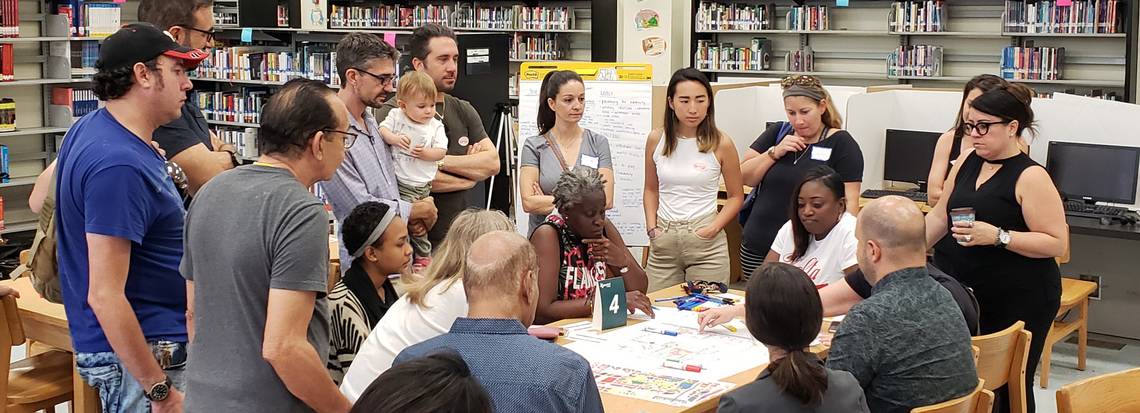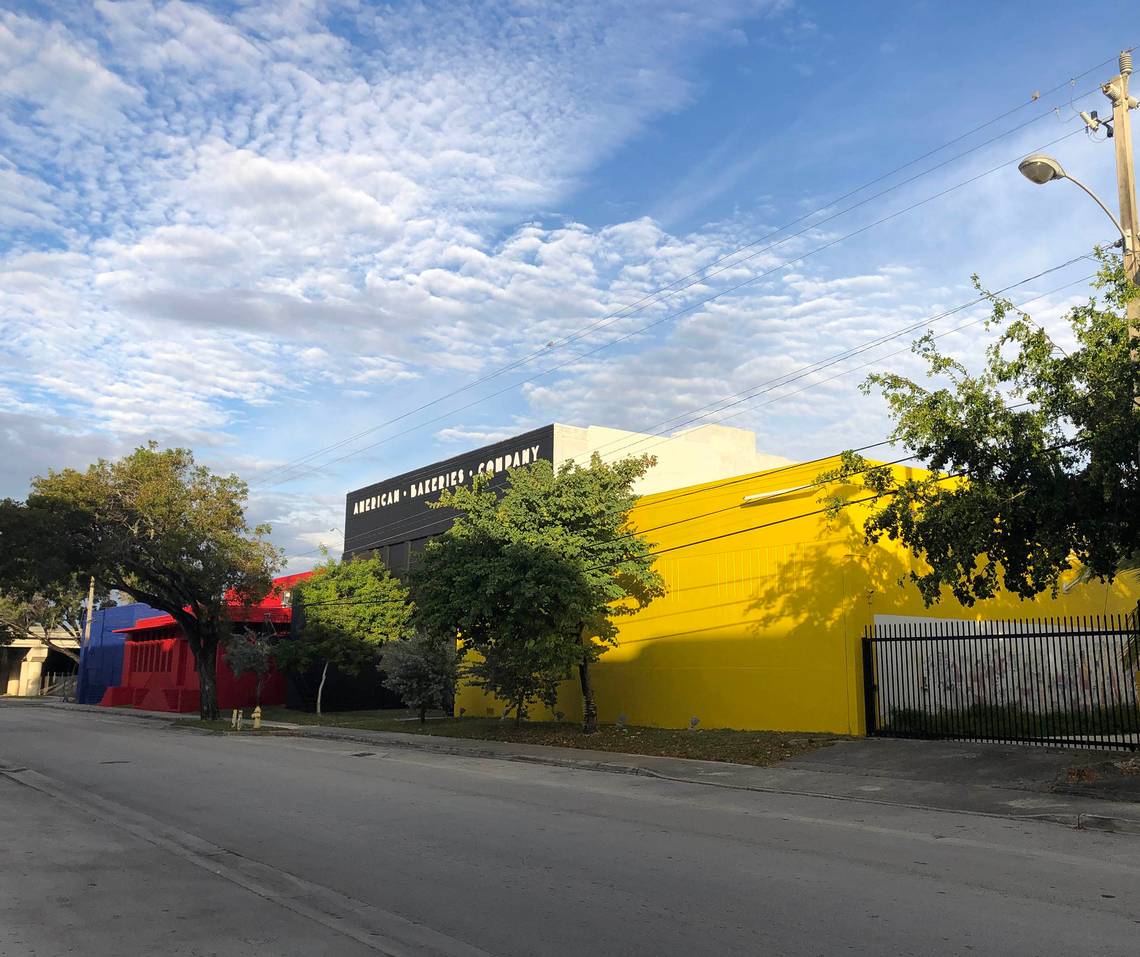MIAMI HERALD: This working-class Miami barrio is geared up for gentrification. Welcome to Wynwood Norte.
09/20/2019
The initiative in Wynwood Norte was prompted in part as residents watched other nearby neighborhoods attempt to fight wholesale changes only after rents and displacement shot up or major projects were already announced. By getting ahead of the game, they hope to set a template for developers and avoid divisive battles like that over the massive and controversial Magic City Innovation District plan in Little Haiti.
Wynwood Norte residents and property owners huddle with planning consultants during a public workshop in May at Jose de Diego Middle School. COURTESY PLUSURBIA DESIGN
They were also inspired by property owners in the Wynwood arts district who organized a business improvement district and got the city to approve special new zoning rules that encourage development of apartments and shops and foster improvements in the public realm, but restrict the scale and mass of new construction to ensure compatibility with the existing aesthetic.
Wynwood Norte residents and property owners enlisted the support of the one large developer that’s announced plans for a significant project in the neighborhood. In 2017, Texas-based Westdale Real Estate Investment Management bought a block of mostly rundown residential properties and obtained city zoning approvals for a plan to raze them and build a low-scale housing and retail complex aimed at a range of incomes, including so-called workforce housing.
A Westdale partner is a Wynwood Norte association director. The firm paid for the neighborhood vision plan by Plusurbia Design, the Miami planning firm that also developed the award-winning Wynwood arts district zoning plan, as well as a community-driven master redevelopment plan for Little Havana.
Steve Wernick, an attorney who has represented Westdale and has been involved in the Wynwood Norte effort as a consultant and volunteer, said the developer’s interests mesh with those of the neighborhood: to ensure compatible development that will enhance the value of its project and its chances of success.
But he stressed the impetus and direction are coming from the community, including leaders of nonprofits and service agencies in the neighborhood, such as Bakehouse interim director Cathy Leff, who is an association leader.
Separately but in coordination with the association’s initiative, the Bakehouse has worked with Wernick on a strategic plan to renovate its historic building, an Art Deco former industrial bakery that houses some 60 artists’ studios, and add affordable housing for artists.
“There is no other neighborhood that is planning the way this community is, “ Wernick said. “The community is saying, ‘Things are going to change, so let’s plan for that change. How can we grow in an appropriate way that allows the community to stay?’
“It’s an invitation to the city and the county and the school board to take a look at neighborhood, to work with the association to implement the community vision. It’s definitely a balanced approach.”
The Bakehouse Art Complex, housed in a former industrial bakery, in the Wynwood Norte neighborhood. BAKEHOUSE ART COMPLEX
Wynwood Norte has seen better days.
Many Puerto Rican garment and factory workers owned homes in the neighborhood’s heyday, earning it the nickname of Little San Juan. But most Puerto Ricans are long gone, replaced by Cubans and later Central Americans, though the borincano flavor remains, mostly in names of places and institutions taken from the island.
The city park, which includes a baseball diamond, is named Roberto Clemente Park, after the Puerto Rican major-league hall of famer. The local Catholic church, Mission San Juan Bautista, takes its name from Puerto Rico’s patron saint and its architecture from the island’s Spanish Colonial period. El Jibarito food market, named after the island name for its peasants, is still a draw on the neighborhood’s main street, Northwest Second Avenue. José de Diego Middle School honors a leader of Puerto Rico’s movement for independence from Spain.

The San Juan Bautista Catholic mission church in Wynwood sits just north of the block that a Texas developer wants to redevelop. GALERIA DEL BARRIO
But the Puerto Rican community that gave rise to the historic names is mostly a thing of the past. As the garment industry declined and disappeared, so did the garment workers who lived in the neighborhood. As it declined, Wynwood was plagued by crime, gangs and drug trafficking. In 1988, days of rioting ensued after undercover police bludgeoned a neighborhood drug dealer to death.
Today, much of the population is a transient one, planners say. Over 80 percent of Wynwood Norte residents are renters, the association’s study says, though the population is trending younger. The neighborhood is dotted by vacant lots where houses were demolished; about 10 percent of Wynwood Norte is vacant land. Much of the remaining housing stock is deteriorated, though a few homes have been renovated in recent years by new owners moving into the area.
Wynwood Norte residents today are among the city’s poorest. The median household income in the neighborhood is $19,800, and the median rent is $672, according to city of Miami planners. Fully a quarter of dwellings are officially designated affordable housing, including some public housing units, though some of it is not in good condition, the Plusurbia study says.
Neighborhood businesses are faltering or disappearing. Dracula Video, for instance, long a mainstay on Northwest Second Avenue, moved out last year after the building that housed it was purchased, Vasquez said. Even the public schools are undersubscribed. Hartner Elementary and the Young Men’s Preparatory Academy are only at 50 percent capacity, planners say.
Though there is plenty of low-cost housing, it’s in such bad shape that the neighborhood is attracting few families, Wernick said. That means it can’t capitalize on its status as one of Miami’s last largely residential zones in the urban core, he said.
”It has remained very sleepy, but not in a way people are happy about,” he said. “There are lots of absentee landlords. Families that want to live in the neighborhood, they don’t have a lot of options. Professionals who want to live and work in the urban core don’t have a lot of options.”
The Plusurbia plan would seek to foster compatible redevelopment through zoning tweaks to encourage incremental infill rather than large-scale projects, the typical Miami model. It calls for increasing allowable density while capping heights at four to five stories, and allowing developers extra square footage in exchange for payments into an affordable housing fund for the neighborhood.
The plan also urges creation of a program of small grants to homeowners to underwrite repairs and renovations, and loosening of zoning rules to permit the addition of detached “in-law” quarters in single family home lots that allow for multi-generational living, or can be rented to boost family income and provide more affordable housing options.
On the public side, the plan says the city and Miami-Dade must replace the neighborhood’s cracking sidewalks, improve street lighting and add to its thin tree canopy.
The recommendations are the result of community consensus hammered out in public workshops, one-on-one meetings with local leaders, an online survey and walking tours of the neighborhood during which planners interviewed people on the street, said Plusurbia principal Juan Mullerat.
“Everyone understood it needs to densify. Everyone was fearful additional density would displace them,” Mullerat said. “But overall we found there is room to grow within the neighborhood without displacing residents.
“The whole idea here is that almost every recommendation is about mitigating displacement, increasing the affordable housing stock and supporting the existing residents.”
One large problem that the plan would address, Mullerat said, is the suburban zoning assigned to Wynwood Norte by the city’s Miami 21 code, which does not allow sufficient density. The reason there is so much vacant land and little new housing in the area, he said, is that the rules make it unfeasible to develop there — a common problem in similar neighborhoods across the city, such as Little Havana.
Those rules, Mullerat and other critics say, require too much parking onsite and too little building, making it almost impossible to physically fit it all in on a typical lot. That’s one reason why the typical Miami model of redevelopment is for an owner to amass multiple lots and build on a large scale, which displaces residents and helps drive up the cost of new housing.
But that’s what’s likely in store for Wynwood Norte if the rules are not amended, Mullerat and Wernick argue.
“If current conditions remain, doing nothing will lead to displacement, in my mind,” Wernick said.
Yet Wynwood Norte already has the basics for success, stakeholders say. It is centrally located, dense, compact and eminently walkable, even if the sidewalks are cracking and the tree canopy thin. Social services, including a senior center, and Clemente Park are located on the business district main street. It’s a short stroll to Midtown Miami’s shops and restaurants and to Wynwood nightlife, both sources of jobs as well as diversion for residents.
“It is because the location,” Vasquez said. “Wynwood is like a small little island, but there’s something always happening around it. Anybody that lives in Wynwood, you have everything at your fingertips. You don’t even need a car. You can take an Uber everywhere you need to go.”
The Bakehouse, meanwhile, has an ambitious plan that aims to turn it into a true community anchor.
The center opened in 1986, after it was purchased by the city for an artists’ nonprofit to address a need for affordable working studios. At the time, artists were being pushed out of Coconut Grove by rising rents and redevelopment. Today, they’re being pushed out of the Wynwood arts district and downtown Miami.
As Miami’s art scene grows, but affordable neighborhoods become increasingly rare, the need for housing for artists is a bigger need than ever, Leff said. The center is seeking zoning changes for its property to allow construction of up to 250 units of housing.
Under a covenant signed when the city turned over the property, the bakery building must be preserved for artists’ use. So the development plan envisions a new residential building on the site, much of which is a parking lot or underused property, Leff said. The center expects to recruit investors or a developer to take on the housing portion, she said.
The residential building would tie the Bakehouse more closely to the neighborhood, which would also benefit from the addition of hundreds of new residents to patronize businesses, Leff said.
“We don’t want to overdevelop. Everybody recognizes the unique character of the neighborhood. We want to make sure whatever we do is in sync with the neighborhood,” Leff said.
If the Wynwood Norte plan succeeds, Mullerat hopes it will become a new model for redevelopment in Miami — saving and enhancing what’s already there, instead of tearing it all down and building on a massive scale.
“It’s been really a ground-up project. The neighbors have been very involved. It’s not developer-centric,” Mullerat said.
“You are not going to do it tomorrow. We must create funding mechanisms that can fund all these lofty goals. It’s going to take time. But we need to start appreciating what we have.”